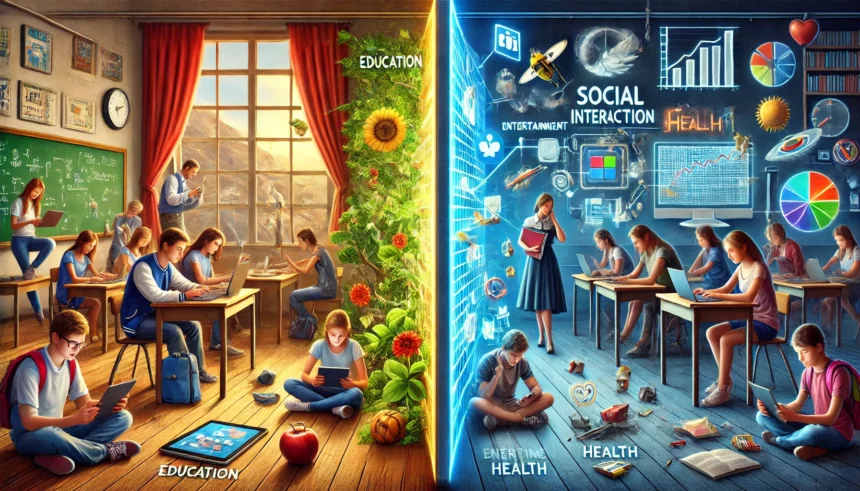Introduction
Technology has woven itself into every part of students’ lives, influencing how they learn, communicate, and unwind. It has changed the way students access information, interact with peers, and even manage their health. Let’s dive into how technology impacts students daily and the benefits and challenges it brings.
Educational Impact of Technology
Online Learning Platforms
Websites like Coursera, Khan Academy, and Udemy offer a vast range of courses for all levels and interests. These platforms allow students to learn at their own pace and explore subjects beyond their regular curriculum.
Digital Classrooms
Tools like Google Classroom and Microsoft Teams have become essential, especially during the COVID-19 pandemic. They help teachers deliver lessons, assign homework, and stay connected with students, ensuring learning continues seamlessly even outside the classroom.
Educational Apps
Apps like Duolingo and Photomath make learning interactive and fun. Duolingo uses gamification to teach languages, while Photomath helps students solve math problems by simply taking a picture of the equation. These apps make studying more engaging and accessible.
Social and Communication Impact
Social Media
Platforms like Instagram, Snapchat, and TikTok are central to students’ social lives. They help students connect with friends, share experiences, and stay updated on trends. According to a Pew Research Center study, 95% of teenagers use social media, highlighting its widespread use.
Instant Messaging
Apps like WhatsApp and Facebook Messenger allow students to communicate instantly with friends and family through text, voice, and video calls, keeping them connected at all times.
Online Communities
Forums like Reddit and Discord offer students a place to discuss common interests, seek advice, and collaborate on projects. These communities provide support and a sense of belonging, especially for those with niche interests.
Entertainment and Leisure
Streaming Services
Services like Netflix, Spotify, and YouTube offer endless entertainment options. Students can watch movies, listen to music, and follow their favorite creators. Statista reports that 70% of young people in the U.S. use streaming services daily.
Video Games
Gaming platforms like PlayStation, Xbox, and PC provide immersive entertainment. Video games can be relaxing and stimulating, with esports even offering career opportunities for some students.
Digital Reading
Platforms like Kindle and Audible give students easy access to a wide range of books and audiobooks, making it convenient to read and listen to literature for both education and relaxation.
Health and Well-being
Screen Time
Too much screen time can lead to issues like eye strain, sleep problems, and reduced physical activity. The American Academy of Pediatrics suggests limiting recreational screen time to two hours per day to mitigate these risks.
Mental Health
While social media can enhance social connections, it can also contribute to anxiety, depression, and cyberbullying. A Royal Society for Public Health study found that Instagram and Snapchat are linked to higher levels of anxiety and depression among young people.
Fitness and Health Apps
Apps like MyFitnessPal and Headspace promote healthy lifestyles by encouraging physical activity and mindfulness. They help students set fitness goals, practice meditation, and improve overall well-being.
Academic Performance
Enhanced Learning Tools
Online databases, educational software, and interactive simulations provide additional resources that support students’ studies and help them understand complex concepts better.
Distractions
While technology offers many benefits, it also brings distractions like social media notifications and online games, which can affect students’ focus and productivity. Managing these distractions is crucial for maintaining academic performance.
Online Research
Platforms like Google Scholar and JSTOR make it easier for students to access academic papers and journals, enhancing their research capabilities and learning.
Future Trends
Artificial Intelligence
AI can personalize learning by providing customized educational experiences. AI tutors and adaptive learning platforms can cater to individual student needs, improving their academic outcomes.
Virtual Reality
VR can transform education by creating immersive learning environments that simulate real-life scenarios, making education more interactive and engaging.
Internet of Things
IoT can enhance the learning environment by connecting various devices and providing real-time data. Smart classrooms equipped with IoT devices can increase the efficiency and effectiveness of education.
Conclusion
The influence of technology on students’ daily lives is significant and multifaceted, affecting their education, social interactions, entertainment, health, and academic performance. As technology continues to advance, its role in students’ lives will grow even more substantial. Understanding and managing its impact is essential to ensure students can leverage its benefits while minimizing potential risks. By embracing innovative tools and maintaining a balanced approach, students can navigate the digital landscape effectively, enhancing their learning and overall well-being.
















